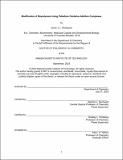Modification of Biopolymers Using Palladium Oxidative Addition Complexes
Author(s)
Rodriguez, Jacob J. L.
DownloadThesis PDF (15.35Mb)
Advisor
Buchwald, Stephen L.
Pentelute, Bradley L.
Terms of use
Metadata
Show full item recordAbstract
Chapter 1: Introduction to the Chemical Modification of Biopolymers This chapter introduces biopolymers as a discrete chemical entity via a brief historical account of the field of protein biochemistry. Other details such as the therapeutic role of key biopolymers, chemical modification strategies, palladium organometallic chemistry, and the recent developments in Pd-mediated bioconjugation are provided as well to give context for the following chapters.
Chapter 2: Amphiphilic Biaryl Monophosphine Ligands by Regioselective Sulfonation Amphiphilic ligands are valued for their ability to facilitate organometallic reactions in the presence of water. The regioselective sulfonation of a series of commercially available biaryl monophosphines to generate amphiphilic ligands is presented. In this one-step protocol, the temperature and addition of fuming sulfuric acid were carefully controlled to arrive at sulfonated biaryl monophosphine ligands in high yields with >95% regioselectivity without the need for chromatographic purification.
Chapter 3: Palladium Mediated Synthesis of Protein–Polyarene Conjugates Catalyst transfer polymerization (CTP) is widely applied to the synthesis of well-defined πconjugated polymers. Unlike other polymerization reactions that can be performed in water (e.g., controlled radical polymerizations and ring-opening polymerizations), CTP has yet to be adapted for the modification of biopolymers. Here, we report the use of protein–palladium oxidative addition complexes (OACs) that enable catalyst transfer polymerization to furnish proteinpolyarene conjugates. These polymerizations occur with electron-deficient monomers in aqueous buffers open to air at mild (≤37 °C) temperatures with full conversion of the protein OAC and an average polymer length of nine repeating units. Proteins with polyarene chains terminated with palladium OACs can be readily isolated. Direct evidence of protein–polyarene OAC formation was obtained using mass spectrometry, and all protein–polyarene chain ends were uniformly functionalized via C–S arylation to terminate the polymerization with a small molecule thiol or a cysteine-containing protein.
Chapter 4: Oligonucleotide Bioconjugation with Bifunctional Palladium Reagents Organometallic reagents enable practical strategies for bioconjugation. Innovations in the design of water-soluble ligands and the enhancement of reaction rates have allowed for chemoselective cross-coupling reactions of peptides and proteins to be carried out in water. There are currently no organometallic-based methods for oligonucleotide bioconjugation to other biomolecules. Here we report bifunctional palladium(II)-oxidative addition complexes (OACs) as reagents for highyielding oligonucleotide bioconjugation reactions. These bifunctional OACs react chemoselectively with amine-modified oligonucleotides to generate the first isolable, bench stable oligonucleotide-palladium(II) OACs. These complexes undergo site-selective C-S arylation with a broad range of native thiol-containing biomolecules at low micromolar concentrations in under one hour. This approach provided oligonucleotide-peptide, oligonucleotide-protein, oligonucleotide-small molecule, and oligonucleotide-oligonucleotide conjugates in >80 % yield and afforded conjugation of multiple copies of oligonucleotides onto a monoclonal antibody.
Chapter 5: Chemoselective Modification of mRNA Using Palladium Oxidative Addition Complexes Therapeutics derived from mRNA rely on non-canonical, covalent modifications to be effective. Chemically altered, non-natural nucleotides are heavily incorporated into therapeutic mRNA resulting in reduced immunogenicity and prolonged stability which, together, significantly enhance translation. While these alterations to mRNA chemical structure have been extensively studied, larger modifications, like conjugates of mRNA to proteins and other large nucleic acids, are comparatively underexplored. Herein we use chemoenzymatic methods to append in vitro transcribed mRNA with a thiol, allowing for further derivatization including the formation of a palladium mRNA oxidative addition complex (OAC).
Date issued
2023-09Department
Massachusetts Institute of Technology. Department of ChemistryPublisher
Massachusetts Institute of Technology